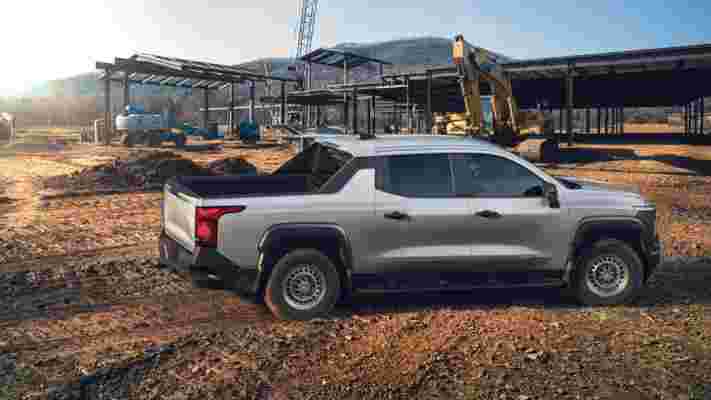US automotive giant GM has officially unveiled its upcoming electric pick-up, the Chevrolet Silverado EV – and it looks set to go toe-to-toe with Ford's F-150 Lightning in almost every department.
Lifting the lid on the battery-powered beast at CES 2022 , GM announced that the Silverado will ship in two variants, a basic work truck (the WT) and a fully-loaded luxury model (the RST), some time in 2023. The former will start at $39,900, with the latter set to cost an almighty $105,000.
For comparison, Ford's electric equivalent – which is expected to arrive between March and June this year – is expected to start at $39,974. But the similarities don't stop there.
Both automakers claim their respective pick-ups will be able to shoot from 0-60mph in around 4 seconds (4 for the Ford, 4.5 for the Chevy), though GM has only revealed the speed stats for its pricier RST version. That same version is set to boast 664bhp and 780 lb ft of torque, which narrowly surpasses the F-150 Lightning's 555bhp and 775 lb ft of torque.
We don't expect the regular Silverado to lag too far behind when it comes to power, mind.

Both the WT and RST versions of the Chevy will, however, share identical range and charging specs. GM says each model will be capable of up to 400 miles of range on a full charge – that's 100 miles further than the Ford – and use standard DC fast charging up to 350kW.
The Silverado will also grant users up to 10.2kW of offboard power (with optional equipment) to charge their homes during a power outage, which is comparable to the 9.6kW figure offered by the Lightning.
Broadly speaking, then, GM's standard Chevy Silverado is set to match Ford's electric pick-up in most areas. It's likely to be slightly slower (although we're talking fractions of a second) and offer less torque, but what it loses in power behind the Ford it'll more than make up for in range.
Bang for your buck
Naturally, though, the RST version of the Silverado hopes to justify its six-figure price tag with a few more bells and whistles.
GM says the first edition model will ship with four-wheel-drive, adaptive air suspension and expandable cargo space, as well as the industry's "first true hands-free driver-assistance technology" – which will allegedly allow drivers to travel hands-free on more than 200,000 miles of compatible roads across the US and Canada.

Then there's the interior displays. The Chevy Silverado RST will boast a large 17-inch LCD infotainment screen alongside an 11-inch instrument panel, which itself sits below a multi-colored heads-up display (HUD) offering a field of view over 14 inches.
It's also no surprise that the RST's body styling is decidedly more aggressive than that of the standard work version. Seriously, you won't want to be coming face-to-face with this brute of a machine in the Oregon woodland.
Whichever variant of the Silverado you've got your eye on, though, GM's automotive pedigree appears to have translated into the electric re-imagining of its iconic pick-up.
What's more, the company announced (in name only) two more electric SUVs – the Chevy Equinox EV and Blazer EV – at its CES 2022 conference, so we're expecting plenty more noise from the automaker as the year rolls on.
BlackBerry 5G: why the anticipated neo-Blackberry phone will never release
The Blackberry 5G remained one of the most anticipated smartphones we'd heard about, ever since it was first announced in mid-2020... up until the project was officially canceled in 2022.
This was a much-hyped revival for the nostalgia-riddled Blackberry brand, though one being pushed by a company other than Blackberry itself.
The company at the helm of this ill-fated project was security company OnwardMobility, which had evidently bought the rights to put out new Blackberry phones.
Companies putting out handsets under other names is nothing new - HMD Global makes Nokia phones, and before OnwardMobility, TCL was using the Blackberry name.
But this new project seemed different - OnwardMobility was rather new to the hardware game, and seemed motivated by an infectious passion for Blackberry phones which inspired fans of the brand.
Well, even the best-laid plans can fall apart, and in February 2022 OnwardMobility confirmed "no longer be proceeding with the development of an ultra-secure smartphone with a physical keyboard".
So what happened? And how did it happen? Well, let's follow along with the events.

BlackBerry 5G timeline
The Blackberry line hasn't exactly been dormant since original company Research In Motion, or Blackberry Limited, stopped making phones under the name in 2017. However the hey-day of QWERT keyboard-toting productivity phones was certainly in the rear-view mirror.
From 2016 to late 2020, Chinese tech firm TCL signed up to release phones under the Blackberry name, and we saw a small smattering of devices like the KeyOne . However it seems that TCL struggled with the same issue that Research In Motion did - in a world of fantastic touch-screen phones, physical keyboards had become a niche proposition.
That's not to say that there's no place for keyboard phones, and some users swear by them.
This kind of user got to come out in force in mid-2020 when a little-known Texan company called OnwardMobility purchased the rights to the Blackberry name.
You can see a video of the company's CEO, Peter Franklin, announcing the new Blackberry below.
Fans were excited: OnwardMobility promised a 5G phone with a QWERTY keyboard, lots of features and top-notch security. More, the website implied future Blackberry 5G products would be coming too.
OnwardMobility also promised that this device would be coming to consumer markets too, so anyone could buy it.
Understandably, there was a lot of excitement. Blackberry phones are coming back? And back with a bang? Take my money!
At the time, OnwardMobility pledged to release the device in 2021, and in an interview with Nikkei Asia in February of the year, Frankling said 'more details will be announced within the next few months.' At the time, we thought that could mean a product reveal as soon as May 2021.
Clearly that wasn't to be, though, as May sailed past with nary a word from the fruity company. And then so did June.
In July 2021, OnwardMobility opened up a waitlist for updates about the upcoming 5G BlackBerry phone. That suggested a release is nearing, but the terminology used also suggested that it may be a bit of a longer wait.
A longer wait was indeed in store, because 2021 limped onwards and, by the time it had collapsed in a pile and made way for 2022, we still hadn't heard anything about the Blackberry 5G. At all.
Some fans were upset, more were confused. Many had just forgotten about the device entirely.

The radio silence was finally broken in January 2022 when the company confirmed that the phone had faced delays but was still in the works . Well, that's not bad news, right? A delayed phone is better than no phone at all!
That is, until a report from a Blackberry fan site posted a report suggesting that the Blackberry 5G dream was, in fact dead. Well, that's not good.
Less than two weeks later, the report was confirmed - and not only was OnwardMobility shuttering the Blackberry project, but it was closing down itself.
In a post on its website the company confirmed "it is with great sadness that we announce that OnwardMobility will be shutting down", and said "we will no longer be proceeding with the development of an ultra-secure smartphone with a physical keyboard".
So dream of a new Blackberry 5G are dead... for now. But as we can see with TCL and OnwardMobility picking up the baton, tech companies won't let the Blackberry name rest, and perhaps in a few years, we'll see another brand try.

So what happened?
The Blackberry 5G from OnwardMobility isn't coming because the company shut down. But digging deeper, what happened to delay and then cancel the launch of this device?
Officially, there's not been any comment on this topic, and the message OnwardMobility posted on its website doesn't say anything. But that report from a Blackberry fan site we mentioned has some theories.
Apparently, the current CEO of Blackberry Limited (a company which still makes software and security tech) has been trying to distance the company from smartphones, as a recent sale in Blackberry's patents suggests. The theory is that the CEO soured on the idea of a new Blackberry smartphone.
Beyond that, it's very possible that OnwardMobility found it'd bitten off more than it could chew. We often see new companies try to make smartphones and give up after a few tries, and presumably it's a lot harder than it seems.
That's all speculation though, and unless someone breaks the silence, it's impossible to know for sure. Hopefully that'll happen, as we're sure it's a fascinating story.
Canon's CES 2022 launches are ambitious shots at reinventing the consumer camera
Canon is the only major camera brand at CES 2022 , which gave it a great opportunity to blow us away with its vision of the future of photography. Instead, the camera giant launched into an uncharacteristic dive into moonshot ideas that are, while laudable, almost certainly too far outside its comfort zone to succeed.
Canon's two big ideas at the electronics expo are its AMLOS system, a gesture-based software platform for video meetings, and Kokomo, a social VR platform for 'immersive' video calls. Both are attempts to reimagine its cameras as essential tools for our new socially-distanced age. But they're also worryingly big stretches for a conservative company that isn't renowned for its software innovation.

Before we take them too seriously, aren't AMLOS and Kokomo just light-hearted concept candy for the future-gazing fest that is CES 2022? That's true to an extent – CES has increasingly become a playground for brands to mock up ideas that give them an innovation halo, and Canon has certainly got in the spirit of things.
But the ambitiousness of both of its concepts also hints at the rough waters the camera industry finds itself in. Smartphones have pushed camera sales back down to their film-era niche, which means camera announcements at CES have become vanishingly rare. So what does an elder statesman like Canon do in a sea of start-ups and vaporware? It could, like Sony, talk about all the ways its planning to help creators in 2022, but instead Canon went off-piste into the forests of VR and a new video-calling platform for Microsoft Teams.
Fresh perspectives
To be fair, Canon's AMLOS system is, in theory, a handy new tool for certain video calls. First announced at CES 2021, the software (whose name stands for 'Activate My Line of Sight') is able to give participants multiple views of the same meeting from a single camera, thanks to its automatic cropping powers. It also lets a presenter use hand gestures to, for example, quickly take screenshots of a whiteboard.
The clever part is the automatic processing that AMLOS carries out to create these views and screenshots. In Canon's CES 2022 demo, the software pulled out a front-on view of a whiteboard that was positioned at an awkward angle to the camera, by cropping and processing the livestream. A open-palm hand gesture in front of the Canon EOS R5 also neatly captured a shot of the camera.

But a couple of limitations mean that AMLOS, which Canon says will be available "in the first half of 2022", is still likely a niche innovation. Firstly, while the software works with any type of camera, Canon recommends one of its PTZ (Pan, Tilt, Zoom) models like the Canon CRN 300 or CRN 500 for the best experience. These cost $2,699 / £2,249 / AU$3,579 and $5,399 / £4,499 / AU$7,149 respectively.
Also, for most people's video meetings, the whiteboard shown in Canon's demos has been replaced by cloud docs, which are easy to view in video meetings without an expensive camera.
Virtual insanity
Similar barriers will also likely constrain Canon's even more ambitious Kokomo software. This will apparently let you meet friends and family in VR video calls that are based in locations like Malibu, New York or Hawaii. The downside? You'll need a compatible Canon camera, VR headset and a compatible smartphone , and it's not yet clear which models these will include, or when the software will land.
VR video calls are something that very few people have asked for – many of us are, after all, reluctant to even upgrade our laptop's webcam – and Kokomo has been slightly overshadowed by the announcement of the PSVR 2 at CES 2022.

Also, Canon's disclaimer about Kokomo, which states that "no assurances can be given that this software, in the current or any other form, will be made available for sale or use in the U.S. or elsewhere", doesn't exactly inspire confidence that it'll still be around by CES 2023.
In reality, Kokomo is likely a promotional tool to show off Canon's new dual-fisheye lens , which it announced in October 2022. The Canon RF 5.2mm f/2.8L Dual Fisheye is the world's first lens for digital interchangeable lens cameras that can shoot 180-degree VR video, and was used to shoot Kokomo's tropical backgrounds. It would also have made a far better CES 2022 keynote announcement, had the launch schedules lined up.
Next frame
Ultimately, the future of VR video is still extremely uncertain, given VR's inability to break into the mainstream. And while Canon has understandably jumped into the world of work video calls, it's not yet clear how long-term these pandemic-related trends are going to be.
Rather than a VR-based moonshot, couldn't Canon make a photography-based app like Glass to provide a home for those fleeing from Instagram? Or why not make a next-gen companion app for its cameras that blows away the average competition? Innovations in computational photography, live streaming or camera accessories would all have been great fodder for CES 2022, too.
Instead, Canon's CES 2022 announcements show that the camera giant has really given up on wooing a new mainstream audience over to its home turf of photography. Its real innovations, like Eye Control AF or its SPAD sensor , are reserved for professional cameras, and now it's looking for new consumer spaces to plant its imaging flag. Whether those include VR video calls and Microsoft Teams software remains to be seen.